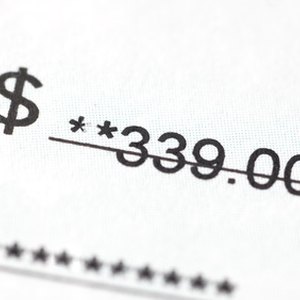
The American Bankers Association (ABA) established a way to facilitate the bundling and sorting of checks and steer them to the correct financial institution. This is called the routing number.
But once it arrives at your financial institution, it needs to be charged to the right bank account. The check needs your checking account number. So, where is your checking account number located on a check?
Account Number Location
From a personal finance perspective, it’s important to understand the numbers on your paper checks. There are a series of numbers at the bottom of a check. These numbers contain your bank routing number, account number and your check number. No matter what you look up in your checkbook, these numbers will not only be on the personal check, but in the same order.
To find your account number, go to the bottom of the check. You will see a series of numbers that are separated by colons. The first series of numbers is a nine-digit number, which the ABA says is your routing number. The second set of numbers is your account number. This number is often between eight to 12 digits long but could be a maximum of 17 digits, mentions Chase.
Your check number is the last in the series of numbers.
Direct Deposit and Account Number
You will need your routing number and account number to set up a direct deposit to your bank account. You will also need a voided personal check from your financial institution. The voided paper check verifies your bank account information and minimizes mistakes.
The ABA routing number is needed so that the funds will arrive at the correct financial institution. The account number is your unique identifier that tells the financial institution which bank account to deposit the check in.
Bill Payments Use Paper Checks
When you pull out your checkbook to make bill payments with paper checks, you are giving the payee the correct information to cash your personal check. The payee needs to know the bank routing number and full account number to ensure that the funds are withdrawn from the correct financial institution and checking account. By using paper checks to make bill payments, you’re able to keep a hard copy record.
Electronic Payments and Wire Transfers
Although you can make many online bill payments with a credit card or debit card, some businesses, like utilities, don't accept these methods. You'll need to give them information so they can withdraw funds from your financial institution.
Although you won’t need a paper check, you’ll need to look up the information on your personal check. Look at the bottom of the check for a series of numbers. The first set of numbers is the routing number, and the second set of numbers is the checking account number.
Wire transfers will need the recipient’s bank account information. Bank of America explains that a wire transfer is a transfer of funds between banks. If you want to make a wire transfer to someone else's account, you must have their ABA routing and bank account numbers. You'll also need a name and dollar amount.
Bank Statement and Debit Card
Although a bank statement will have your bank account number, it won’t have your financial institution’s routing number. Instead, it will have a list of your transactions. Besides showing debit card transactions, it will also show, by date, the check number of any personal checks you've processed with payees.
Business Check vs. Personal Check
Personal checks always have a series of numbers in the same order. They are routing number, bank account number and check number. However, business checks sometimes deviate from this sequence. Depending on the financial institution, a business check may have the check number first.
But if you're looking for the account number, it will always follow the routing number, which is a nine-digit number. The bank account number length will vary and can be shorter or longer than the routing number.
References
Writer Bio
Anne attended University of Akron and went on to have a career in television sales. Working as a commercial property and casualty insurance agent for nine years allowed her to learn about different businesses' needs. She has also owned an advertising agency where she created marketing capaigns for various clients. Anne has written for several publications. She currently resides in Charleston, SC.

